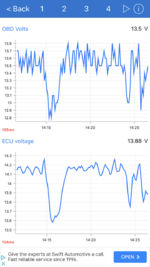It usually starts out just fine, and goes awhile before I sense it go sluggish. At that point, it does switch back and forth during the drive, but I don't notice the exact moments of the switch because i believe they happen when the engine isn't loaded. For example, I might accelerate off the line and everything feels fine. I come to a steady drive speed, then i decide to accelerate to pass or something, and that's when it might feel sluggish. If I ask for a little more, it will stay sluggish like I'm in too high a gear for the speed I'm traveling. Kinda like in a Manual when you're doing 20mph in 4th gear and punch it. It just kinda moans at you. If I ask for a lot more it will drop a gear increase the RPM, and it won't feel sluggish at that point, but it's hard to say if that's just thanks to the extra gear ratio. I have not ever noticed it become sluggish in the middle of an acceleration if the acceleration started off peppy.
Yes, I just have one of those bluetooth OBD readers that I link to with my phone. So, I can have my phone on the dash to watch variables. I can also graph up to two variables at a time. More if I pay for the pro version....but I'm not there yet
Yes, I just have one of those bluetooth OBD readers that I link to with my phone. So, I can have my phone on the dash to watch variables. I can also graph up to two variables at a time. More if I pay for the pro version....but I'm not there yet

